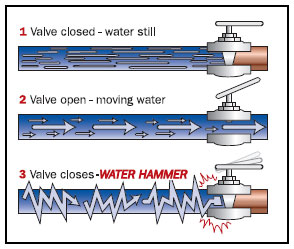Archives
Five ways to find water hammer in a stud wall.
In an earlier post we asked, “Do Hot and cold water pipes get water hammer?” Determining the location of loose pipes that cause water hammer in a stud wall can be challenging, as the pipes are typically hidden behind drywall or other wall coverings. However, there are several methods that can be used to locate the problem area:

- Sound: One of the most common ways to locate loose pipes is by listening for the sound of water hammer. This is the banging or knocking sound that occurs when a valve or faucet is quickly closed.
- Visual Inspection: If possible, removing a section of drywall or other wall covering in the area where the sound is heard can reveal the location of the pipes. You can also look for signs of water damage or staining on the wall or ceiling.
- Using a stud finder: A stud finder can be used to locate the studs behind the drywall, which will give you an idea of where the pipes are located.
- Tracer wire: If you have access to the attic or crawl space, you can trace the pipes with a tracer wire, which is a wire that is attached to the pipe and can be followed through the wall.
- Hiring a plumber: If you are unable to locate the problem area or are unsure about the best course of action, it is recommended to consult a plumber, who will have the knowledge and tools to locate the loose pipes and make necessary repairs.
Do Hot and Cold Pipes get Water Hammer?
Water hammer can occur in both hot and cold water pipes. It’s caused by a sudden change in the velocity of water flow, like when a valve or faucet is quickly closed. This sudden change in velocity can cause a pressure wave to travel through the pipe, creating the banging or knocking sound that is characteristic of water hammer.
The main cause of water hammer is water pressure that is too high, which causes the water to move too quickly through the pipes. This can happen in both hot and cold water pipes, and can be caused by a variety of factors such as worn out valves, loose pipe connections, or improper pipe installation.

In some cases, the problem is more likely to occur in hot water pipes because hot water is less dense than cold water, and therefore is more susceptible to changes in velocity. However, it is possible for water hammer to occur in both hot and cold water pipes, so it’s important to address the issue as soon as it is detected.
Read our earlier post What is Water Hammer and How to Stop It here
Common pipelines; easements, ownership and liability #2

One recurring topic of 2010 is the Ownership and liability of common water, sewer and gas pipes.
When we send out an emergency response team to a ruptured gas or water pipeline or an overflowing sewer, the first thing our team thinks about is rescuing the property under threat. Often, it is after the emergency that ownership and liability of the problem are hotly debated.
This series of 3 blog posts is aimed at clarifying some of that debate.
Our friends at the Law Reform Commission have helped to clarify this interesting subject and in part it reads:
A user of a service may attempt to disconnect the joint service and force other users of the service to bear the cost of a direct connection to the main service. Such action will however, be illegal unless conducted in accordance with the Water Board Act 1987 (Water Board (Plumbing and Drainage ) Regulation 1989),2 or a court order declaring that the common user of the service has a right to discontinue the service.
The creation of permanent rights of access is seen as a means of avoiding problems of access in respect of utility services, and applications have been made to the courts over the years to have access to and over utilities such as water pipes and sewers recognised as easements of necessity. The courts have, however, gone to considerable lengths to hold that although such an easement may be considered by a landowner to be essential for the reasonable enjoyment of property, it is not an easement of necessity, because at law, easements over such services are not considered necessary to the land itself.
Although DP 22 raised the possibility of statutory recognition of these “trespassing” services as a means of rectifying the problem, the Board of Surveyors pointed out in their submission that few authorities know with any exactitude the location of their service lines. Consequently, the Board of Surveyors opposes the creation of statutory easements over them until such time as they are properly defined on title. The Commission agrees that such a step may be expensive and premature at this stage. It would seem desirable however, that steps are taken in the long term by the relevant authorities to locate such services, properly record them and establish the appropriate rights over them.
